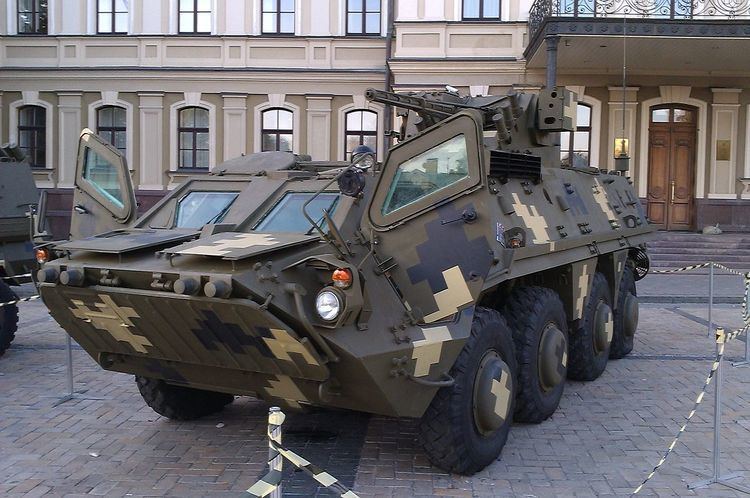In service IraqUkraine | ||
 | ||
Type Armoured personnel carrier Weight 17.5+3% T (with anti-bullet protection)25+3% T (with additional protection) | ||
The BTR-4 "Bucephalus" (BTR; Ukrainian: Бронетранспортер / Bronetransporter, literally Armoured Transporter) is a 8x8 wheeled armoured personnel carrier (APC) designed in Ukraine by the Kharkiv Morozov Machine Building Design Bureau (SOE KMDB) as a private venture. The prototype, which was designed as a private venture, was unveiled at the Aviasvit 2006 exhibition held in Ukraine in June 2006.
Contents
Description
The layout of the BTR-4 represent a change compared to the older BTR-60/70/80 designed in the Soviet Union. The vehicle has a conventional layout similar to western designs like the German TPz Fuchs with the driver's and commander's compartment at the front part of the hull, the engine and transmission compartment in the middle, and the troop compartment at the rear. The troops enter and leave the vehicle either through the rear doors or the roof hatches, and the driver and the commander are provided with doors located on the sides of the hull.
The BTR-4 is a more flexible design than the older BTR-60/70/80s as the changed layout makes it easier to adapt the vehicle to specialized roles. The vehicle can be armed according to customer requirements. The prototype is armed with the locally designed New Armament Module which is armed with one 30mm automatic cannon, 7.62mm coaxial machine-gun, up to four 9P135M Konkurs or Baryer anti-tank missiles (two on each side of the turret), and one 30mm automatic grenade launcher (fitted in place of the AT missiles on one left-hand side of the turret). It can also be fitted with different turret weapons modules: the GROM module, SHKVAL module, and the BAU 23x2 module.
The BTR-4 has a maximum speed of 110 km/h and can cross water obstacles at a speed of 10 km/h. The vehicle is powered by a 3TD diesel engine with 500 hp. It was reported to being hit by several rpg rounds and multiple small-arms fire with no consequences. Slat armor can be fitted for maximum protection against RPG attacks.
A serial production started in late 2008, first series of ten BTR entered service in the army of Ukraine in 2009.
Combat history
On 4 June 2014, company officials revealed that the BTR-4E was being used in military operations in the Sloviansk area. Its armor had withstood hits from large-caliber machine guns, counter-HEAT side screens protected the crew from anti-tank grenade launchers, and armored glass sustained direct hits from sniper rifles.
BTR-4s that are actually being used by Ukrainian armed forces in the ATO operations come from the rejected batch for the Iraqi army. They were found with rust and damaged hulls and thus never accepted by Iraq. Likewise, Azerbaijan refused to purchase the BTR-4 over welding flaws and difficulty in transporting them. Their original desert camo as seen on Iraqi BTR-4s can be noticed in pictures and videos from ATO operations. Two Ukrainian BTR-4 were captured by the pro-Russian separatists in repairable state.
The Iraqi army used BTR-4s in an operation to recapture Jurf Al Sakhar from ISIL forces on October 24, 2014, successfully repelling two road-side ambushes.
Versions
Weapons modules
Standard module:
GROM module:
SHKVAL module:
BAU 23x2 module:
BTR-4KSh command and staff vehicle:
MOP-4K fire support vehicle:
